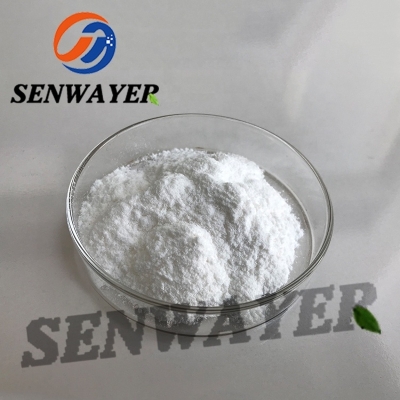What innovative therapies will the Nobel Prize winning "oxygen sensing pathway" bring?
-
Last Update: 2019-10-08
-
Source: Internet
-
Author: User
Search more information of high quality chemicals, good prices and reliable suppliers, visit
www.echemi.com
Yesterday, the 2019 Nobel Prize in physiology or medicine was announced Professor William g kaelin, Professor Peter J Ratcliffe, and Professor Gregg L Semenza were honored for their research on the critical oxygen sensing pathway for the survival of humans and most animals Professor William g kaelin (left), Professor Peter J Ratcliffe (middle), and Professor Gregg L Semenza (right) (photo source: reference [1]) won the Nobel Prize for scientific research, which is not only an important breakthrough in basic research, but also often breeds innovative therapies that change disease treatment For example, Professor James Allison and Professor Ben Shuyou, who won the Nobel Prize in physiology or medicine last year, and their research on CTLA-4 and PD-1, not only directly brought about the anti-cancer therapy yevoy targeting CTLA-4 and opdivo targeting PD-1, but also gave birth to the emergence of immunosuppressive therapy, completely changing the pattern of cancer treatment So which patients will benefit from this year's Nobel Prize winning "oxygen sensing pathway"? Today, the content team of Wuxi apptec will explore with readers the innovative therapies brought about by this signal pathway HIF-1 protein is the core part of oxygen sensing pathway of innovative therapy for anemia It can activate many genes in animal cells that respond to hypoxia environment, including VEGF, erythropoietin (EPO), etc The proteins expressed by these genes can stimulate the production of red blood cells, vascular proliferation and other physiological processes, and help the body get more oxygen ▲ the schematic diagram of organism's oxygen sensing pathway (picture source: reference [2], credit: Cassio lynm) the innovative therapy targeting this pathway has shown excellent effect in the treatment of anemia patients The level of red blood cells in the body of anemic patients is insufficient to transport enough oxygen to all parts of the body In the treatment of anemia, Amgen's recombinant human erythropoietin (EPO) is an effective therapy with a history of 30 years EPO is also a downstream target of oxygen sensing pathway, regulated by HIF-1 protein In recent years, many biomedical companies have developed innovative therapies to regulate the human body's response to hypoxia by improving the level of HIF-1 protein Because HIF-1 protein can regulate many physiological processes related to the solution of hypoxia, including the production of red blood cells and the transport of iron, the regulator targeting HIF-1 protein is expected to achieve better therapeutic effect than EPO ▲ the mechanism of action of hypoxia inducible factor proline hydroxylase inhibitor (hif-phi) (picture source: reference [3]) at present, at least six hif-phi are in the stage of clinical development HIF prolinyl hydroxylase can degrade HIF by proteasome through modification of HIF, thus reducing the level of HIF in the body It is an important regulatory mechanism for cells to reduce HIF level in oxygen enriched environment Hif-phi can improve the level of HIF-1 by inhibiting the effect of HIF prolyl hydroxylase, so as to alleviate anemia The "first in class" HIF phi roxadustat, jointly developed by fibrogen, AstraZeneca and astralas, was first approved in China in December last year to treat anemia caused by chronic kidney disease in patients undergoing dialysis This year, it was approved not only in China to expand indications, but also in Japan to treat renal anemia patients without dialysis treatment In addition, molidustat of Bayer and daprodustat of GSK have also submitted new drug applications in Japan, while vadadustat of Akebia therapeutics and desidustat of zydus Cadila are in phase 3 clinical development stage ▲ part of hif-phi molecular structure formula (photo source: meodipt [public domain]) innovative treatment for cancer in a variety of cancers, due to the rapid proliferation of cancer cells, it usually causes local oxygen shortage near the tumor, so cancer cells often improve the expression of HIF-1 α protein, stimulate the vascular proliferation of the body, and provide more oxygen and nutrients for the tumor In addition, different gene mutations can also increase the expression of HIF-1 α, including the functional acquired mutations of carcinogenic genes (such as erbB2) and the loss of function mutations of tumor suppressor genes (such as VHL and PTEN) HIF-1 regulated genes are closely related to tumor metabolism, proliferation, survival and metastasis, as well as tumor angiogenesis Therefore, inhibiting the function of HIF-1 protein and its related protein (HIF-2 α) has become one of the important directions in the research and development of anticancer drugs ▲ some cancer-related genes regulated by HIF-1 (photo source: reference [4]) however, there is no approved HIF inhibitor The main challenge of this research and development direction is to find specific HIF inhibitors Another reason that may reduce the effect of HIF inhibitors is that the functions of different members of HIF protein family can complement each other For example, studies have shown that knockdown of HIF-1 α results in a compensatory increase in HIF-2 α expression This means that if we want to inhibit the growth of cancer, we may need to target HIF-1 α and HIF-2 α at the same time Due to the important function of HIF signaling pathway in stimulating the proliferation of red blood cells, anemia is a common side effect of HIF inhibitors, which will also affect their safety in the treatment of cancer patients Currently, anticancer therapies targeting HIF signaling specifically include "first in class" HIF-2 α inhibitor pt2977 developed by peleton therapeutics It can specifically bind to HIF-2 α and inhibit the binding of HIF-2 α to HIF-1 β It is currently used in phase 2 clinical trials to treat patients with advanced renal cell carcinoma associated with VHL MSD bought peleton in May for $2.2 billion Another anti-cancer therapy targeting HIF signaling pathway is Roche's antisense oligonucleotide therapy ro7070179 targeting HIF-1 α This antisense oligonucleotide therapy is currently used in phase 1b clinical trials to treat patients with HCC The results showed that ro7070179 could reduce the mRNA level of HIF-1 α in patients with stable and partially relieved HCC Conclusion in addition to the treatment of anemia and cancer, HIF-1 α stabilizer is also used to treat inflammatory bowel disease Academic research shows that HIF-2 α may also be a new target for the treatment of nonalcoholic steatohepatitis It's not easy to turn breakthrough scientific research into innovative therapies that change patients' lives It has been 15 years since Mr Thomas Neff, founder of fabergin, founded the company, and Rosas has been approved in China The Nobel Prize winning RNA interference (RNAi) technology took 12 years from the Nobel Prize winning to the birth of the first RNAi therapy We look forward to the news that "oxygen sensing pathway" won the Nobel Prize, which can promote the development of innovative therapies based on this pathway and bring new treatment options to patients as soon as possible Photo by Adam Baker,'Nobel Prize Medal in Chemistry'CC BY 4 (https:// via Flickr reference: [1] The Nobel Prize in phycology or medicine 2019, retrieved October 7, 2019, from https:// [2] 2016 Albert Lasker Basic Medical Research Award: Oxygen sensing – an essential process for survival, Retrieved October 7, 2019, from http:// [3] Beck et al., (2018) Discovery of Molidustat (BAY 85-3934): A Small-Molecule Oral HIF-Prolyl Hydroxylase (HIF-PH) Inhibitor for the Treatment of Renal Anemia ChemMedChem, DOI: 10.1002/cmdc.201700783 [4] Soni and Padwad, (2018) HIF-1 in cancer therapy: two decade long story of a transcription factor Acta Oncologica, https://doi.org/10.1080/0284186X.2017.1301680 [5] Gossamer Bio Retrieved October 7, 2019, from https:// [6] FibroGen, Inc Corporate Presentation Retrieved October 7, 2019, from https://fibrogen.gcs-web.com/static-files/c82c7b58-d8d5-4567-93b6-0e85ac6b2105 [7] Akebia Therapeutics Retrieved October 7, 2019, from https://akebia.com/research-and-development/vadadustat.aspx [8] Yu et al., (2017) Development of Inhibitors Targeting Hypoxia-Inducible Factor 1 and 2 for Cancer Therapy Yonsei Medical Journal, Doi: 10.3349/ymj.2017.58.3.489 [9] Xie et al., (2017) Activation of intestinal hypoxia-inducible factor 2α during obesity contributes to hepatic steatosis Nature Medicine, https://doi.org/10.1038/nm.4412 [10] Merck to Acquire Peloton Therapeutics, Bolstering Oncology Pipeline Retrieved October 7, 2019, from https://investors.merck.com/news/press-release-details/2019/Merck-to-Acquire-Peloton-Therapeutics-Bolstering-Oncology-Pipeline/default.aspx [11] GSK submits first regulatory application for daprodustat in Japan for patients with renal anaemia due to chronic kidney disease Retrieved October 7, 2019, from https:// [12] Wu et al., (2019) Evaluation of a locked nucleic acid form of antisense oligo targeting HIF-1α in advanced hepatocellular carcinoma World J Clinical Oncology, doi: 10.5306/wjco.v10.i3.149
This article is an English version of an article which is originally in the Chinese language on echemi.com and is provided for information purposes only.
This website makes no representation or warranty of any kind, either expressed or implied, as to the accuracy, completeness ownership or reliability of
the article or any translations thereof. If you have any concerns or complaints relating to the article, please send an email, providing a detailed
description of the concern or complaint, to
service@echemi.com. A staff member will contact you within 5 working days. Once verified, infringing content
will be removed immediately.







